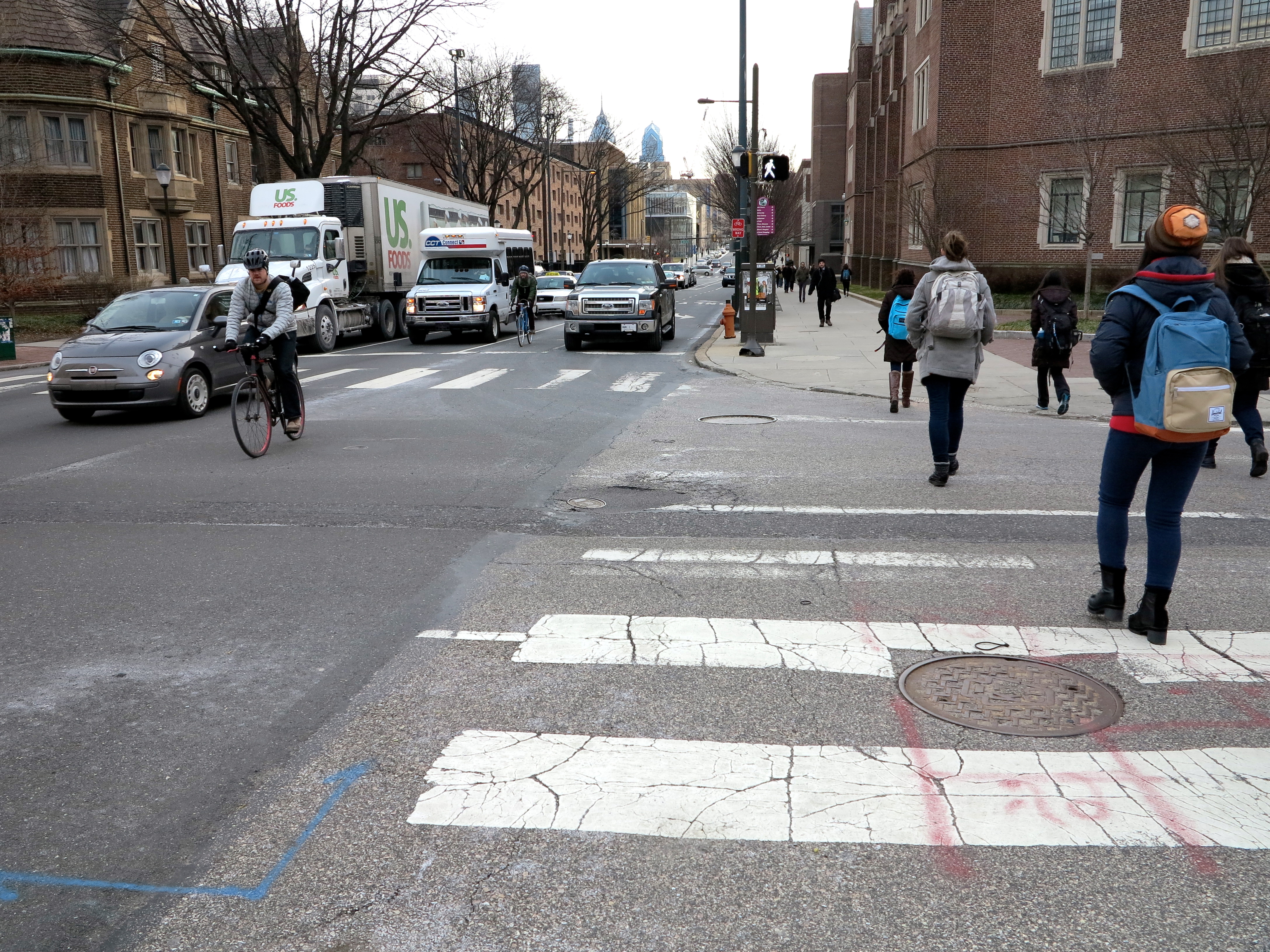How the Next Mayor Can Save Lives and Money

This week the Bicycle Coalition’s Sarah Clark Stuart kicks off our election themed op-ed series arguing why Philly should become the next city to adopt Vision Zero policies to make our streets safer for all users. It’s part of the Better Mobility 2015 platform.
Traffic violence is not inevitable. And it’s not an “accident.” Every year in Philadelphia, nearly 100 people—pedestrians, motor vehicle drivers and bicyclists—are murdered in traffic. In addition to poor decisions and lack of compliance with traffic rules, outdated road designs and a lack of resources and funding to fix them contribute to these deaths.
Based on the data from 2009-2013, 94 people, on average, died in motor vehicle crashes. Of them, 33 were pedestrians.
While the number of persons who died in crashes overall declined 6 percent over that time period, the percentage of pedestrians killed actually increased 16 percent. It’s therefore more dangerous to be a pedestrian today in Philadelphia than it was in 2009, even though drivers and bicyclists are statistically safer. One traffic death is one too many, but the trajectory for pedestrians is particularly alarming.
There’s a solution to this problem. It’s called Vision Zero, which is a set of policies that governments use to reduce and ultimately eliminate traffic deaths. Vision Zero has been adopted by countries, states and cities to address the problem of traffic violence head on. And Philadelphia should be next.
Vision Zero grew out of Sweden in 1997, when the country’s parliament adopted the goal to fully eliminate all highway deaths and injuries. Since then, it has spread to other jurisdictions. Most recently, New York City and San Francisco. And already, New York City has made headlines with its Vision Zero legislation, like when it lowered its speed limit last year to 25 miles per hour.
The scale of Philadelphia’s traffic deaths is important to put into context. In 2013, 89 people died in motor vehicle crashes in Philadelphia. Homicides claimed 247 lives and fire claimed 23. So, motor vehicle crashes are claiming three times as many women, men and children as fires and is one-third the number of people who are murdered.
But, what is the level of resources being devoted to these three types of fatalities? The City currently budgets at least 30 times as many resources into the departments that address murders and fires as compared to the department that needs to be retrofitting city streets to make them safer. It’s gotten so bad, we at the Bicycle Coalition reported recently that the Streets Department has a paving backlog of more than 900 miles—more than a quarter of all the city’s streets.
Philadelphia is taking some steps to reduce the sort of traffic violence that results in $1 billion in avoidable economic loss to the city each year.
Early in the Nutter Administration, buffered bike lanes were installed on Spruce and Pine. According to the Mayor’s Office of Transportation & Utilities, reportable crashes between 2010-2012 declined 26% after the installation of the Spruce/Pine buffered bike lanes, as compared to the number of crashes that occured between 2006-2008.
The City has identified the ten most dangerous pedestrian corridors for pedestrian crashes, and recently received a national highway safety grant to address three corridors in particular. Philadelphia has been using red-light enforcement funding to change signal timing, improve street lighting, signage and bump-outs and plans to also modify intersections and install traffic-calming roundabouts.
But, more is necessary.
Speed and convenience should no longer trump safety. Increased traffic enforcement, redesigned intersections and corridors, wider use of safety cameras, and protected bike lanes should be invested in and deployed to make Philadelphia’s streets safer and reduce crashes, fatalities and injuries.
In the Better Mobility 2015 platform, the Bicycle Coalition of Greater Philadelphia and numerous other organizations have come together to call for the next Mayor and Council to adopt ten strategies, including a Vision Zero goal and to develop an implementable action plan to reduce traffic fatalities and injuries by 50 percent by 2020. And a Better Mobility mayoral forum in late March is scheduled to give candidates an opportunity to articulate their commitment to Vision Zero and other mobility issues such as protected bike lanes and making sidewalks safer.
How can our elected officials realize a Vision Zero policy? Well, for starters, set a fatality and injury reduction goal by a deadline and convene an intra-departmental task force to develop a highly focused action plan that will accomplish a reduction in deaths and injuries. Then allocate sufficient funding to the agencies who can implement the plan. Getting traffic deaths down to zero requires making it a priority and providing the necessary resources to get the job done. It won’t happen by accident.
Want more?
- Read up on the Better Mobility 2015 platform.
- Attend the Better Mobility 2015 Mayoral Forum, March 19, 6-8pm. RSVP here.
WHYY is your source for fact-based, in-depth journalism and information. As a nonprofit organization, we rely on financial support from readers like you. Please give today.




